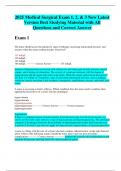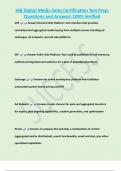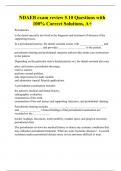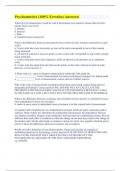2025 Medical Surgical Exam 1, 2, & 3 New Latest
Version Best Studying Material with All
Questions and Correct Answer
Exam 1
The nurse should assess the patient for signs of lethargy, increasing intracranial pressure, and
seizures when the serum sodium reaches what level?
115 mEq/L
130 mEq/L
145 mEq/L
160 mEq/L ----------- Correct Answer ---------- 115 mEq/L
Features of hyponatremia associated with sodium loss and water gain include anorexia, muscle
cramps, and a feeling of exhaustion. The severity of symptoms increases with the degree of
hyponatremia and the speed with which it develops. When the serum sodium level decreases to
less than 115 mEq/L (115 mmol/L), signs of increasing intracranial pressure, such as lethargy,
confusion, muscle twitching, focal weakness, hemiparesis, papilledema, seizures, and death, may
occur.
A nurse is assessing a client's reflexes. Which condition does the nurse need to confirm when
tapping the facial nerve of a client who has dysphagia?
hypervolemia
hypercalcemia
hypomagnesemia
hypermagnesemia ----------- Correct Answer ---------- Correct response:
hypomagnesemia
Explanation:
If there is a unilateral spasm of facial muscles when the nurse taps over the facial muscle, it is
known as Chvostek's sign, which is a sign of hypocalcemia and hypomagnesemia. The additional
symptom of dysphagia reinforces the possibility of hypomagnesemia rather than hypocalcemia.
A positive Chvostek's sign does not apply to hypercalcemia, hypervolemia, or hypermagnesemia.
a nurse is a Sting with the care of a client who had a cardiac catheterization via the right femoral
artery which of the following actions should the nurse take to prevent post procedure
complications ----------- Correct Answer ------------ monitor the insertion site for bleeding second
maintain the pressure dressing check the clients peripheral pulses
,a nurse is contributing to the plan of care for a client who has multiple sclerosis and is taking d a
n t r o l e n e to manage muscle spasms which of the following intervention should the nurse
include ----------- Correct Answer ------------ encourage the client to complete ADL
this is caring for a client who is at risk for developing pressure ulcers which of the following
actions should the nurse take ----------- Correct Answer ------------ position pillows between bony
prominence
What does the nurse recognize as one of the best indicators of the patient's renal function?
BUN
Serum creatinine
Correct response:
Serum creatinine ----------- Correct Answer ---------- Serum Creatinine
Creatinine is the end product of muscle metabolism. It is a better indicator of renal function than
BUN because it does not vary with protein intake and metabolic state.
A client presents with severe diarrhea and a history of chronic renal failure to the emergency
department. Arterial blood gas results are as follows:
pH 7.30
PaO2 97
PaCO2 37
HCO3 18
The nurse would expect which of the following sets of assessment findings?
Clammy skin, blood pressure 86/46, headache
Confusion, respiratory rate 8 breaths/min, dry skin
Blood pressure 188/120, nausea, vomiting
Headache, blood pressure 90/54, dry skin ----------- Correct Answer ---------- Clammy skin,
blood pressure 86/46, headache
Metabolic acidosis, a common clinical disturbance, is characterized by decreased pH and plasma
bicarbonate concentration. Common causes of metabolic acidosis include diarrhea, chronic renal
failure, use of diuretics, intestinal fistulas, and ureterostomies. The client will experience the
following signs and symptoms: headache, confusion, increased respiratory rate, nausea,
vomiting, cold and clammy skin, and decreased blood pressure.
A nurse evaluates a client's laboratory results. What is a factor that may be affecting an increase
in serum osmolality?
free water loss
diuretic use
overhydration
hyponatremia ----------- Correct Answer ---------- free water loss
,Osmolality measures the solute concentration per kilogram in blood and urine. Water loss in the
serum would increase the solute concentration. Free water loss is a factor increasing serum
osmolality. Diuretic use, overhydration, and hyponatremia are factors decreasing serum
osmolality.
The nurse is conducting a lecture on the difference between hypovolemia and dehydration. When
completing a verbal comparison, which point needs clarified?
Similar causes are present in both conditions.
Hypovolemia contains only low blood volume.
In dehydration, only extracellular is depleted.
Both conditions result in abnormal laboratory studies. ----------- Correct Answer ---------- In
dehydration, only extracellular is depleted.
Explanation:
In clients diagnosed with dehydration, all fluid compartments including the intracellular and
extracellular compartment are reduced. The other options are correct. Both states can be from
similar disease process such as vomiting, fever, diarrhea and difficulty swallowing and also have
abnormal lab work. It is correct that hypovolemia relates to low blood volume.
The health care provider ordered an IV solution for a dehydrated patient with a head injury.
Select the IV solution that the nurse knows would be contraindicated.
a. 0.9% NaCl
b. 5% DW
c. 0.45% NS
d. 3% NS ----------- Correct Answer ---------- Correct response:
b. 5% DW
Explanation:
A solution of D5W is an isotonic IV solution that is contraindicated in head injury because it
may increase intracranial pressure.
A client diagnosed with hypernatremia needs fluid volume replacement. What intravenous
solution would be the safest for the nurse to administer?
0.45% sodium chloride
0.9% sodium chloride
5% dextrose in water
5% dextrose in normal saline solution ----------- Correct Answer ---------- Correct response:
0.45% sodium chloride
Explanation:
A hypotonic solution (half-strength saline) is the solution of choice and considered safer than 5%
dextrose in water because it allows a gradual reduction in the serum sodium level, thereby
decreasing the risk of cerebral edema. An isotonic solution (0.9%) is not desirable as a
, supplement because it provides Na and CL.
A client is diagnosed with syndrome of inappropriate antidiuretic hormone (SIADH). The nurse
should anticipate which laboratory test result?
Serum sodium level of 124 mEq/L
Serum creatinine level of 0.4 mg/dl
Hematocrit of 52%
Serum blood urea nitrogen (BUN) level of 8.6 mg/dl ----------- Correct Answer ---------- Correct
response:
Serum sodium level of 124 mEq/L
Explanation:
In SIADH, the posterior pituitary gland produces excess antidiuretic hormone (vasopressin),
which decreases water excretion by the kidneys. This, in turn, reduces the serum sodium level,
causing hyponatremia, as indicated by a serum sodium level of 124 mEq/L. In SIADH, the serum
creatinine level isn't affected by the client's fluid status and remains within normal limits. A
hematocrit of 52% and a BUN level of 8.6 mg/dl are elevated. Typically, the hematocrit and
BUN level decrease.
Early signs of hypervolemia include
a decrease in blood pressure.
thirst.
moist breath sounds.
increased breathing effort and weight gain. ----------- Correct Answer ---------- Correct response:
increased breathing effort and weight gain.
Explanation:
Early signs of hypervolemia are weight gain, elevated blood pressure, and increased breathing
effort. Eventually, fluid congestion in the lungs leads to moist breath sounds. One of the earliest
symptoms of hypovolemia is thirst.
Which of the following would be appropriate nursing interventions for a client with
hypokalemia? Select all that apply.
Offer a diet with fruit juices and citrus fruits.
Administer the ordered Kayexalate enema.
Administer the ordered furosemide 60 mg po.
Monitor intake and output every shift.
Administer the ordered potassium 40 mg IV push. ----------- Correct Answer ---------- Correct
response:
Offer a diet with fruit juices and citrus fruits.
Monitor intake and output every shift.
Explanation:







